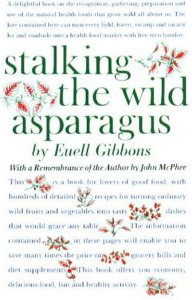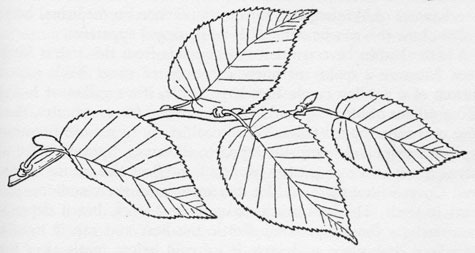Stalking the Wild Asparagus

Classic guide to wild foods
There’s a bunch of watercress growing wild at the low end of our creek. And wild plums thick at the upper end. And stinging nettles in between, and all three of them delicious. I know this because I first read Euell Gibbon’s charming book on foraging for wild food 50 years ago. All these years later it’s still one of the best books on finding wild foods in North America. It won’t help you identify the edible plants and critters; there’s no photos, only a few minimal line drawings, and very little in terms of identification help. Gibbons assumes you’ll use other sources, including friends, to help you learn to distinguish them.
What Gibbons offers in his books (including his sequels on herbs and beachcombing), is what to do with what you find, and why bother. He is a delightful writer who tells memorable stories about his life-long adventures in discovering wild foods and uncovering (through historical research) how they can be prepared. Gibbons is not concerned about the survival aspects of wild food. For him the adventure is culinary, and an antidote to white bread and office work. It is hard to convey the paucity of cuisine in suburban America at the time he was writing. His passions helped open up American palates. And despite the fact that you can buy dandelion greens, fern fiddles and wild mushrooms at some farmers’ markets today, his books can still open your eyes to the edibles and adventures that lie unseen in your own neighborhoods. I enjoy re-reading him every now and then to be reminded of wild foods I overlook. I’ve used his advice many times. I get an immense and distinct satisfaction from adding even a small bit of wild food to a meal.
09/17/12Excerpt
Another point in favor of foraging as a family is the handiness with which it can be practiced. One doesn't need to go to the mountains or virgin forests to find wild food plants. In fact, mountains and dense forests are among the poorer places to look. Abandoned farmsteads, old fields, fence rows, burned-off areas, road-sides, along streams, woodlots, around farm ponds, swampy areas and even vacant lots are the finest foraging sites.
*
Did you ever stop to think how much specialized knowledge and fine discrimination are required in order to tell a head of cabbage from a head of lettuce on a grocer's shelf? How would you describe the difference, so someone who had never seen either could be certain what he is getting? Or how would you go about telling someone the difference between Swiss chard, beet tops, spin age and turnip greens? yet most of us are not aware of ever having made an effort to learn to discriminate between the common vegetables. We recognize them intuitively, just as we do other familiar things. The same thing becomes true of wild food plants after a short acquaintance.
*
Since then, each spring I go out along the field borders and byways and gather wild asparagus, not only enough for current use, but some to store in the freezer, so I can bring back the joyous spring days any time of the year merely by cooking a dish of wild asparagus. That five minutes I spent so long ago, concentrating on one dead asparagus plant, has led me to many pounds of this most delicious of early vegetables. The eyetraining it gave me has lasted until now. Whenever I drive, in the late winter or early spring, my eye automatically picks up the dead asparagus stalks by the roadside, and I make an almost unconscious mental note of the places where the green spears will be plentiful when warm weather returns.
*
To make a wintergreen-flavored tea, cut some sweet birch twigs in small pieces and cover them with boiling birch sap. Let it steep for a minute or two, then strain out the twigs and sweeten the tea to taste. Some like to add cream or hot milk. Children are usually very fond of this beverage and it's perfectly harmless and wholesome.
*
For the number of different kinds of food it produces there is no plant, wild or domesticated, which tops the common Cattail. In May and June the green bloom spikes make a superior cooked vegetable. Immediately following this comes the bright yellow pollen, fine as sifted flour, which is produced in great abundance. This makes an unusual and nourishing ingredient for some flavorful and beautifully colored pancakes and muffins. From fall until spring a fine, nutritious white flour can be prepared from the central core of the rootstocks for use as a breadstuff or as a food starch. On the leading ends of these rootstocks are found the dormant sprouts which will be next year's cattails. These can be eaten either as a salad or as a cooked vegetable. At the junction of these sprouts and the rootstock there is an enlarged starchy core the size of a finger joint. These can be roasted, boiled or cooked with meat. In the spring, the young shoots can be yanked from the ground and peeled, leaving a tender white part from six to twelve inches long which can be eaten raw or cooked.
*
Don't feel like a vandal while digging day lily tubers. A spading fork full of plants removed here and there from the clump will only give it a much-needed thinning and cultivation. If you would like to see more of these interesting and useful plants growing, then set out some of the plants in new places after you have remove the tubers. They will live and each one will soon form a new colony about itself.
*
Once I stopped my car by a roadside stream, and in ten minutes speared eight large frogs. A good way is to get right up into the stream, wearing old clothes or fishing waders, and walk up the middle of it, spearing or shooting frogs on either bank.
A head for a frog spear can be bought at most any sporting goods store. It is a small three- or five-tined fork looking something like the trident carried by Poseidon. Many frog-hunters will disagree with me but I think the best handle for a frog spear is made of a good stout piece of bamboo ten to twelve feet long. Such a rig looks as if it were all handle and no spear, but I have walked along narrow streams spearing frogs on the opposite bank with such a long-handled spear very successfully
…The next time you are camping and bullfrogs are keeping you awake, don't fret or become angry. Just lie there and plan a menu for next day's dinner that includes plenty of brown, crispy frog's legs. You'll be surprised how much a difference it will make in that sound.
Stalking The Wild Asparagus Euell Gibbons 2005 (1962), 303 pages $13







